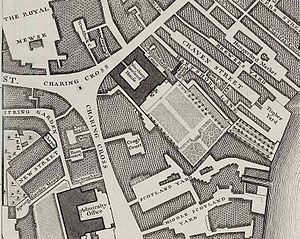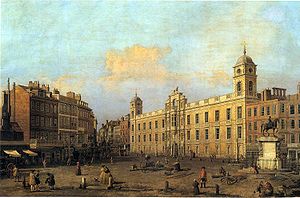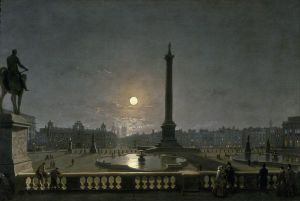- Northumberland House
-
Coordinates: 51°30′27″N 0°7′36″W / 51.5075°N 0.12667°W
The Strand front of Northumberland House in 1752 by Canaletto. Note the Percy Lion atop the central facade.
 An extract from John Rocque's map of London, 1746. The two projecting garden wings had not yet been added.
An extract from John Rocque's map of London, 1746. The two projecting garden wings had not yet been added.
- "Suffolk House" redirects here. For a similarly named mansion in Penang, Malaysia, see Suffolk House, Penang.
Northumberland House (also known as Suffolk House when owned by the Earls of Suffolk) was a large Jacobean mansion in London, which was so called because for most of its history it was the London residence of the Percy family, who were the Earls and later Dukes of Northumberland, and one of England's richest and most prominent aristocratic dynasties for many centuries. It stood at the far western end of the Strand from around 1605 until demolished in 1874. In its later years it overlooked Trafalgar Square.
In the 16th century Strand, which connects the City of London with the royal centre of Westminster, was lined with the mansions of some of England's richest prelates and noblemen. Most of the grandest houses were on the southern side of the road and had gardens stretching down to the River Thames. In around 1605 Henry Howard, 1st Earl of Northampton cleared a site at Charing Cross[1] and built himself a mansion, which was at first known as Northampton House. The Strand facade was 162 feet (49 m) wide and the depth of the house was marginally greater. It had a single central courtyard and turrets in each corner.
The layout reflected medieval traditions, with a great hall as the principal room, and separate apartments for members of the household, who would still at that time have included gentlemen attendants. Many of these apartments were reached from external doors in the courtyard in the manner still seen at Oxbridge colleges. The exterior was embellished with classical ornament in the loose way of ambitious Jacobean buildings. The most striking external feature was the elaborate four storey carved stone gateway fronting the Strand. The garden was 160 feet (49 m) wide and over 300 feet (91 m) long, but unlike those of the neighbouring mansions to the east it did not reach all the way down to the river.
The house passed from Lord Northampton to the Earls of Suffolk, who were another branch of the powerful Howard family headed by the Dukes of Norfolk, and in the 1640s it was sold to the Earl of Northumberland at the discounted price of £15,000 as part of the marriage settlement when he married a Howard.
Regular alterations were made over the next two centuries in response to changes in fashion and to make the layout more convenient for the lifestyle of the day. John Webb was employed from 1657 to 1660 to relocate the family's living accommodation from the Strand front to the garden front. In the 1740s and 1750s the Strand front was largely reconstructed and two wings were added which projected from the ends of the garden front at right angles. These were over 100 feet (30 m) long and contained a ballroom and a picture gallery, the latter itself 106 feet (32 m) long. The style of the new interiors was late palladian and the architects were Daniel Garrett until his death in 1753, and then the better known James Paine. In the mid 1760s Robert Mylne was employed to reface the courtyard in stone, and he may also have been responsible for extensions to the two garden wings which were made at this time. In the 1770s Robert Adam was commissioned to redecorate the state rooms on the garden front. The Glass Drawing Room at Northumberland House was one of his most celebrated interiors. Part of the Strand front had to be rebuilt after a fire in 1780. In 1819 Thomas Cundy rebuilt the garden front five feet further south as the wall was unstable, and in 1824 he added a new main staircase.
By the mid 19th century all of the other mansions on the Strand had been demolished. The area was largely commercial and was not a fashionable place to live. However the Duke of Northumberland of the day was reluctant to leave his ancestral home, despite pressure from the Metropolitan Board of Works, which wished to build a road through the site to connect to the new roads along the Embankment. After a fire, which caused substantial damage, the Duke eventually accepted an offer of £500,000 in 1866. Northumberland House was demolished and Northumberland Avenue was constructed in its place.
One of the largest buildings on Northumberland Avenue was a 500 bedroom hotel called the Victoria Hotel. During the Second World War, it was taken over by the Government for use by the Ministry of Defence and renamed Northumberland House. This "new" Northumberland House was left empty for several years until it was purchased by the London School of Economics for conversion into a student hall of residence. The building opened to students at the start of the 2006-2007 academic year, and rooms are let to tourists during the summer vacation.
An archway from Northumberland House, designed by William Kent was sold for the entrance to the garden of Tudor House, which formerly stood in Bromley-by-Bow. This was moved in 1998, to form the principal entrance to the Bromley by Bow Centre.
References
- ^ The site was the eastern portion of the former property of the Chapel and Hospital of St Mary Rounceval.
- London's Mansions David Pearce (BT Batsford Ltd, 1986) ISBN 0-7134-8702-X
See also
- Alnwick Castle - the Percy family's main seat.
- Syon House - the Percy family's west London residence.
External links
- Northumberland House at the Survey of London online
- Northumberland House and its associations - section of Old and New London Volume 3 (1878)
- http://www.imperial-london.me.uk/northumberland-house.php
Trafalgar Square, London Buildings Clockwise from North: National Gallery (architect: William Wilkins) · St Martin-in-the-Fields (James Gibbs) · South Africa House (Herbert Baker) · Drummonds Bank (Philip Hardwick) · Admiralty Arch (Aston Webb) · Uganda House · Canadian Pacific building · Canada House (Robert Smirke) ·

Memorials Nelson's Column (William Railton, Edward Hodges Baily) · Charing Cross · See all
Architects Charles Barry · Norman Foster · Edwin Lutyens · John Nash
Fourth plinth sculptors Former buildings Royal Mews · Northumberland House
Events Adjacent streets London School of Economics and Political Science Governance Chancellor: HRH The Princess Royal • Director: Professor Judith Rees • Chairman: Peter Sutherland • Visitor: The Rt Hon Nick Clegg • List of Directors
Campus Aldwych • Berrylands • British Library of Political and Economic Science • Clare Market • Covent Garden • Church of Christ the King • The Economists' Bookshop • George IV Public House • Kingsway • Land Registry Building • Lincoln's Inn • Lincoln's Inn Fields • New Academic Building • Old Building • Old Curiosity Shop • Parish Hall • Peacock Theatre • Penguin Statue • St Clement Danes • Shaw Library • Ye Olde White HorseResearch Centres Asia Research Centre • BIOS • Centre for the Analysis of Social Exclusion • Centre for Climate Change Economics and Policy • Centre for Economic Performance • Centre for the Analysis of Time Series • Centre for the Philosophy of Natural and Social Science • Centre for the Study of Human Rights • Crisis States Research Centre • Grantham Research Institute • Financial Markets Group • International Bibliography of the Social Sciences • International Growth Centre • LSE Cities • LSE Global Governance • LSE Health and Social Care • LSE IDEAS • Middle East Centre • Spatial Economics Research Centre • STICERD • TRIUM EMBAHalls of residence Anson Road • Bankside • Butlers Wharf • Carr-Saunders • Grosvenor • High Holborn • Lilian Knowles • Northumberland • Passfield • Rosebery • Sidney WebbStudent life Athletics Union • The Beaver • Clare Market Review • LooSE TV • LSE Students' Union • Pulse Radio • RAG Week • LSE Rowing Club • Union General Meeting • University of London Boat Club • University of London UnionHistory People Other Association of Commonwealth Universities • Association of Professional Schools of International Affairs • CEMS • LSE Enterprise • European University Association • G5 • The General Course • Golden Triangle • Rivalry with KCL and UCL • Russell Group • The Third Way • University of LondonCategories:- Destroyed landmarks
- Former houses of Westminster
- Percy family
Wikimedia Foundation. 2010.


